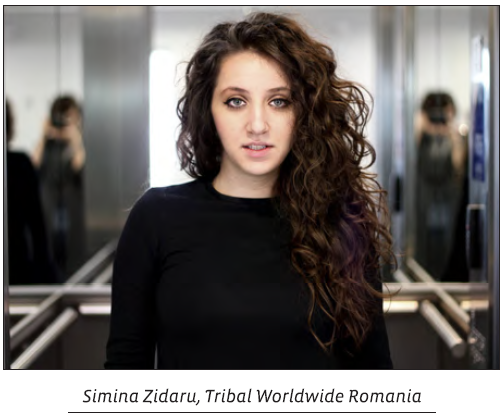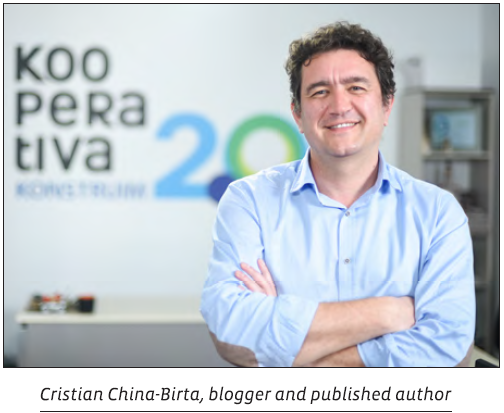:quality(80)/business-review.eu/wp-content/uploads/2021/06/infl.jpg)
One of the best-known Romanian bloggers, Cristian China-Birta, recently launched his first book providing brands with valuable insights into approaching and working with influencers, as well as advice to better understand them. The book taps into a market which is growing rapidly in Romania and has the potential to change the way we see digital campaigns.
By Romanita Oprea
The communication industry has a fast-changing mood, and so does influencer marketing, so we must start understanding this field better and deepen our knowledge if we want to make sure campaigns we work on have a good success rate. According to Golin’s digital manager, Alexandra Ion, marketers are starting to focus more on quality and results rather than brand awareness alone. They’re taking a long term approach and seeking ways to build partnerships that bring great benefits to both sides. They view influencers as partners and not only as communication channels, and this is one of the biggest changes so far. “Another important aspect is their attention to creativity and community skills. When you have a partnership with an influencer, they are your brand’s voice in their community, so you want to make sure that they deliver the right message, in a natural and unique way, and that they are there to engage and interact with the community, no matter the questions that come up,” added Alexandra Ion. Tribal Romania even has an influencer manager in Marie-Claire Borcan, whose mission is to be aware of all the opportunities on the market and choose the right influencers for the agency’s campaigns.
But when should a brand use influencers and when shouldn’t it? “Every brand has to choose the right communication channels for its messages as long as they are aligned to its business objectives. In other words, you should choose to work with influencers whenever they are able pass your message along to your relevant audience to achieve your business objective. However, there are other things to consider before starting an influencer campaign, such as a solid social media presence and a large audience of engaged users,” said Cristian Manafu, social media trainer & consultant and managing partner at Evensys.

In turn, Sabina Cornovac, the owner of SocialPedia and content manager at SavaBros, doesn’t believe that brands should always use influencers and says the approach should be different. “I believe that some brands could achieve certain marketing and business objectives if they chose to include content creators in their strategies,” Cornovac explained, adding that it all starts with the strategy, the objectives, the target, the budgets available in the short and medium term, etc. And if it makes sense to bring content creators along, it should be done after a brand and an image has been created, to have something to promote. “No brand should work with influencers just because it’s a trend or because it’s what the competition is doing. Those reasons cannot form the basis of a relevant collaboration,” she argued.
Cornovac started SocialPedia as an educative project with the goal of contributing to the quality of the Romanian digital community by offering relevant content and connecting beginners and enthusiasts with specialists. Over time, it grew into a very active community that provides answers to all the questions posed on its Facebook Group, which has around 5,600 members (of which more than 80 percent are active), on its website which has published over 1,100 useful resources so far, on Instagram, during monthly events, as well as on Clubhouse, in the SocialPedia Talks club.
“If you start seeing yourself or your close friends as the “target audience,” you might approach things differently, in a way that’s better for your brand. Find influencers with whom you can build a real, long-term relationship, one that’s guided by the same rules as a true friendship. Does it match your life philosophy? Is it relevant for you? Does it spark joy? Does it make you laugh? Is it entertaining? These are some of the questions that should get a positive answer. Just like in a friendship, if you find someone that helps you grow, go for it,” says Simina Zidaru, creative director at Tribal Worldwide Romania.
Timing and strategy

Influencer marketing is an important part of any brand’s marketing strategy, so in Alexandra Ion’s opinion, there isn’t a good or a bad moment to start doing it. Better yet, Golin’s digital manager believes that brands should think more about how they should start collaborating with influencers rather than when, about who they want to collaborate with, and why particular influencers may be relevant for their brand. “But if we must talk about when, then I have to say it’s when the brand understands what influencer marketing is about and only when it has a good strategy in place. There are a few aspects brands must take into account when it comes to influencer marketing. First, seek quality, not quantity for key metrics. Of course, you want your brands’ message to reach as many people as possible, but if you want your brand to be noticed and remembered, you need the right partners to help you communicate. So it’s better to look at the quality of their content and community interactions rather than at how big their audience is,” Alexandra Ion argued.
Moreover, one should aim for long-term, not only campaign-based collaborations. When you have a long-term partnership with an influencer or content creator, you will develop a win-win relationship and you will see better results over time. Your partner will better understand the brand and they will have a stronger connection with it, they will easily and naturally introduce the brand into daily content, the community will start to associate them with the brand and accept branded materials more easily. In other words, you will build trust.
“And finally, trust your partners, especially the agency. We really are one big team fighting for the same things and holding the same objectives and our proposals will always be tailored to your needs,” added the Golin representative.

Meanwhile, Simina Zidaru highlights the importance of creativity. Her advice for brand representatives would be to go against the tide and try new things all the time, create content that only their brand could, find new influencers, break into new communities. For example, Tribal has a working process where they bring people from the social media department and people from the creative department to the same table to brainstorm new ways of approaching influencer campaigns. “Because the ground is still fresh, there are tons of opportunities on how to use influencers in a creative, yet effective way. If it’s the right partnership, the brand will see results on all layers in the long term. Because they basically vouch for what your brand does. And this is huge because somehow, the influencer becomes part of your brand’s DNA,” Zidaru explained.
“The most important thing when a company decides to work with influencers is picking the right ones. And by that I mean those who are relevant to the company’s audience, have an engaged community, and are recognised as experts (they have a long-running experience in that field),” said Cristian Manafu.

Cristian China-Birta points to a very clear definition of the objective of an influencer campaign. He says it should be as specific and precise as possible, and then “translated” into influencers’ language in the brief. “Many campaigns go wrong from the beginning due to the fact that the brand wanted to say one thing, while the influencers understood something else. The best example (and the easiest, because it happens quite often) is when a brand may tell the influencer to say something nice about it. From that, the influencer understands brand awareness, but the brand gets upset because the influencer didn’t send people to its website,” notes Cristian China-Birta. In other words, the request may get lost in translation. The brand wanted a referral campaign, but didn’t know how to say that, and the influencer ended up understanding something totally different.
At the same time, Sabina Cornovac points to the importance of research. Brand representatives should read as many articles as possible on the subject, spend as much time as possible on social media accounts they find interesting and, very importantly, make sure they don’t ignore the voice of communities and the values of influencers. “At the end of the day, if you aren’t a good fit, strategy no longer matters. Last but not least, bi-directional communication is the key to success in a relationship with any influencer. Try to have a clear brief, ask for constant feedback, constantly communicate what may bother you or what you don’t like and encourage your partner to do the same,” Sabina Cornovac concluded.
Change in perception
As for how much marketers’ perspectives have changed in recent years when it comes to their interactions with influencers in Romania, according to Cristian Manafu, there are four types of companies: those who have never worked with influencers; those who tried once and have never gone back; those who refuse to do so for various reasons; and those who actively work with them. This is a global status quo. “Taking all of these into account, I think more and more companies are embracing influencer marketing as they have more opportunities than ever. The niches are getting strong, with micro and nano influencers are being considered. So there’s a long way to go,” said Manafu.
Along similar lines, Cristian China-Birta thinks there is still a lot of misunderstanding between brands and influencers, especially in terms of expectations. According to the blogger, there are still influencers who believe brands are there to give them money because they are cute. Just as how there are marketers that choose to work with influencers because they believe it’s trendy. Both attitudes are, of course, wrong. And they are among the reasons he wrote his book.
“Influencers can help you build brand trust in their communities by constantly communicating about your brand using facts, statistics, and personal experiences, interacting with their followers and asking them to share their personal experiences, and so on. They can easily help a brand in terms of perception, whether we think about improving understanding about a brand or even changing an old or inaccurate perception. Look at influencers as partners and you will get to positive outcomes,” added Alexandra Ion.
In Sabina Cornovac’s opinion, what has changed the most over the past few years has been the communication between specialists and content creators. Those two groups often meet at events and in dedicated groups and this has helped them get to know each other better. “At the same time, I’m seeing more and more long-term partnerships taking shape, increasing the credibility of those collaborations. They are not always the right ones, but I think people have started to look beyond the vanity metrics and understand that, at the end of the day, everything is about money and survival. And that isn’t generated only through likes, shares, and comments. We are always engaged in a learning process, and that is a good thing. How and when will the market become mature? That depends only on us,” Cornovac concluded.
Busting myths about influencer marketing
Simina Zidaru, Tribal:
“I don’t know about myths, but I really think we are at a turning point in the way we partner up with influencers. People are paying more attention to who they follow, more sensitive to what they react to. Content is getting better and better and we must constantly find new ways to be relevant, to be entertaining, to provide powerful insights. It’s a great moment to be an influencer, an amazing opportunity for brands to find the most suitable partners, and a major challenge for agencies to create amazing work!”
Alexandra Ion, Golin:
“Many people think that influencers are all the same, promoting the same brands and sharing the same content. But let’s face it: there are plenty of niches among influencers. Of course, if you only follow fashion influencers, for example, you will definitely see many similarities in their content and get bored at some point. But trying to follow and watch influencers from different areas and on different platforms is the best practice, as you will quickly notice differences and learn lots of new things.
Moving on, some might think that influencers are too expensive. Well, they may be, if we are talking about celebrities and macro-influencers with huge communities. But there are medium, micro, and even nano-influencers with more than decent fees, and they are willing to collaborate with brands. And by the way, they do a very great job of promoting your services, products or campaigns. It’s just a matter of matching the best people with your brand – finding the right balance between reach and relevance, within the given budget.
I also often hear that influencers are like billboards: they don’t really care what they are posting as long as they are getting paid. Indeed, some people do that. But I would avoid calling them influencers. From the very first moment I started working with influencers, I’ve felt that we are partners, with the same objectives in mind. If they’re chosen well, they really want to make the best out of the story by mixing the brand’s message with their everyday content style and tone of voice.
“They won’t move a finger unless they are paid” is another myth that I often hear. Totally not true. I am currently working, have worked and will certainly work again with influencers who are willing to participate in CSR campaigns even when there is no budget available. Why? Because they believe in the cause that we want to promote, because they have similar values to the brand’s, because they want to share this type of content with their communities and they are willing to help if you have the right approach.”
Cristian Manafu, Evensys:
“There are no particular myths regarding Romanian influencers. This trend is relatively new and it is related directly to the rise of YouTube and Instagram. Of course, we used to have online influencers before those two social networks, but visual communication has made this type of marketing a mainstream tactic in the past 10 years.
The myths are pretty much the same anywhere in the world. Influencers need to act as businesses and have the mindset of a marketing agency. They need to learn what responsibility means to their ventures. Usually, a celebrity has a manager who takes care of their entire life and business. Not all influencers have a talent agency or a manager behind their success. That’s why they need to also learn business alongside how to use the latest Instagram filters.”
Cristian China-Birta, aka Chinezu, Influencer, managing partner at Kooperative 2.0. and published author:
“The biggest myth is that they are some sort of Unicorns or Dragons, depending on how you look at them. In fact, they can just be resources for your brand. That, based on a contract, a brief, and a fee, can bring great benefits to your brand. This is how influencers should be perceived. Rationally. In an Excel file. Between the printer paper and a personal growth workshop.
Another myth is that if an influencer has 1 million fans, all of them will become your brand’s fans if you feature that influencer in a campaign. A statement that is false from so many points of view. These ideas around how a brand should work with influencers are wrong. I talk about all of them in my book, which reflects my 15 years of experience in digital marketing and hundreds of influencer campaigns.”
Sabina Cornovac, SocialPedia:
“The word influencer has gathered negative connotations for many reasons, which are strongly connected with the myths we are talking about right now. On the one hand, there are some who mock their communities and partners though what they post and have no trace of responsibility and, as a result, no credibility. This creates the impression that they are all the same. The solution? Target audiences and brands start to ignore them and pay attention to those who deserve it. Because if there are influencers that only do what they want and never take responsibility for their actions and the consequences that follow, nothing good comes out of what happens.
Then there are brands or social media people who don’t like influencers and have been stigmatising them. They’ve either had a bad experience or they just don’t like them out of principle, don’t talk about it in their groups, make no effort to seek relevant content creators, and therefore contribute to a negative image of influencers. The solution? Act professionally, do real research, and talk about facts and data instead of relying on hear-say or only being guided by personal beliefs.
Budgets. They say all influencers are expensive, they don’t do pro bono work, don’t do barters, don’t reply to messages, don’t give reports, don’t have results, etc. It’s a generalisation that badly harms the industry and that again relies on hear-say and on people who don’t have any strategy around this. Moreover, too few of them connect the demanded fees to the possible results (one can pay EUR 1,000 for a really helpful blog article or they may choose to spend that same amount on a story that gets 100k views but doesn’t translate into anything for the brand because it chooses the wrong influencer).



:quality(80)/business-review.eu/wp-content/uploads/2024/07/VGP-Park-Timisoara_-8thbuilding_iulie-24.jpg)



:quality(80)/business-review.eu/wp-content/uploads/2024/06/22C0420_006.jpg)

:quality(80)/business-review.eu/wp-content/uploads/2024/06/COVER-1-4.jpg)



:quality(80)/business-review.eu/wp-content/uploads/2024/06/br-june-2.jpg)
:quality(50)/business-review.eu/wp-content/uploads/2024/07/America-House-Offices-Bucharest-Fortim-Trusted-Advisors.jpg)
:quality(50)/business-review.eu/wp-content/uploads/2024/07/BeFunky-collage-33-scaled.jpg)
:quality(50)/business-review.eu/wp-content/uploads/2024/07/BeFunky-collage-32-scaled.jpg)